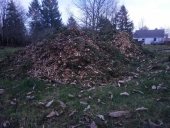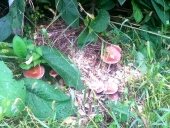









 1
1




Check out Redhawk's soil series: https://permies.com/wiki/redhawk-soil









Check out Redhawk's soil series: https://permies.com/wiki/redhawk-soil
 2
2












Check out Redhawk's soil series: https://permies.com/wiki/redhawk-soil








Check out Redhawk's soil series: https://permies.com/wiki/redhawk-soil




king stropharia grow very well on straw and cardboard so does all oyster mushrooms. make sure you shred them into small pieces. you can take your oyster block , after its done fruiting and break it up into wet cardboard / straw. put in a card board box or burlap sack. put it in a moist dark area outside directly on the ground. must be in contact with soil. i also put a piece of cardboard on top of the burlap sacks to keep in moisture. keep moist but not soaking. in 8 to 10 weeks the sub. should be all white and start to fruiti on the bottom and out the sides. poke a few holes in the sides of the box once you see them fruiting out of the bottom. usually get about 3 flushes out of it. throw whats left in your compost pile. best to keep elms and king stropharia separate but they will grow together . one will win out over the other tho. i use logs to separate the beds. they will fruit best near the logs. good luck!Jennifer Fox wrote:Hmmm...I get my straw from the local feed store. Since I've always used it as garden mulch, I never thought to question what type it is. I will call them and ask. I do live in an area with very low humidity so I'm choosing the most ideal site I can in regards to blocking the wind and I have planned on rigging up some shade cloth as well. It will have the protection of a wall on one side, fence on the other and is partially shaded by a lilac shrub. I also bought a pearl oyster block that I'm fruiting indoors. Would that do well on wood chips too? From some brief research it looks like most people grow it on logs which would be difficult for me to get. If I get Elm Oyster, can I put it in the same area as the King Stropharia or would they compete? I do have another spot under a cherry tree that I've been considering, but it's a little less protected from wind. I've also read that King Stropharia like growing on the corrugated side of cardboard. I have lots of that! I'm guessing that cardboard and straw alone wouldn't have enough nutrition though.












what species are you growing? you would have to sterilize your sub. indoors but if you mixed it into wet sawdust in a cardboard box or burlap sack set outside on the ground in a shady location , it will colonize without contamination in 8 -10 weeks. if you want to spread it further don't let it fruit. just break it up again into prepared beds of sawdust for k. stropharia or elm oysters. you will have much better success outdoors than in if you don't have a sterile area to work..Ken W Wilson wrote:I'm growing my first spawn on sterilized grain sorghum seeds. I purchased the liquid culture separately and inocullated about 5 days ago. It's growing great. We are having a heat wave here. I was wondering how to expand the spawn indoors to plant it outside later. Once it's fully colonized, could I mix it 50/50 without sterilizing the substrate?




 1
1




i haven't had to sterilize since i got my outdoor beds established as i just mix more chips in to keep them going. I've tried mixing in compost and it still doesn't work as well as ground contact for some reason. in your area it should fruit a lot sooner than our zone up here. it takes a full year to produce but once established you get flushes from late may to frost. usually add new material in the fall so they produce next spring. i top dress my beds with some oat straw to keep in moisture. but they produce well with no straw under my bushes and trees. many years i have so many i can't get rid of them fast enough . i dry a lot of them for winter use. our soil is too acidic for morels up here.Ken W Wilson wrote:It's Stropharia rugosoannulata. That's interesting that it works so much better with ground contact. Have you ever tried to simulate that by adding soil?
How do you sterilize? The substrate I bought was autoclaved. CouId I just boil some grain?
I assume it's too late to fruit outdoors this year?
I'm growing some morel spawn, M rufobrunnea, too, but it hasn't done anything yet.
I planted M. importuna outdoors this spring. The substrate was grain on bottom and sawdust on top. The directions said to throw the grain part away. I added it to a bag of sterile substrate instead. It grew but had contaminants. I planted in outdoors in a Earth Box planter. It was doing great last time I checked. The outdoors seemed to cure it. I hadn't thought about it being the soil that did it. I think it was in purchased compost but it had been outside a long time.




 2
2




Check out Redhawk's soil series: https://permies.com/wiki/redhawk-soil




















 2
2








 1
1




Fredy Perlman wrote:Better to continue on an old thread than start a new one! That way the info is easier to archive and find.
Melody, your post was helpful and welcome, as I have some rotting burlap uglying up the place. But when did you start your bed? I have 5.5 lbs of F&F winecap spawn in the fridge because i thought it could start now, but when the instructions arrived from F&F it didn't say that.
If I can start it now in my region, for potential substrates, I have lots of
--wet cardboard (unsterile)
--1 year old alder chips that have been fruiting Gymnopilus luteofolium for months (can those be pasteurized clean?)
--fine maple sawdust (contaminated with chainsaw oil from alaska mill)
--straw (mixed with unrotted horse manure---this straw is not the demon called "weed free", but Timothy hay from eastern WA, no weed seeds or pesticides I'm told, it's fed to much-loved horses)...i could also buy new clean straw.
Thoughts? I'd love to get these li'l ones started!
better to use fresh straw than the other stuff. the bacteria and other fungi will compete w/ your mushroom spawn. layer the cardboard torn up and soaked in water with the wet straw . break up your spawn into small pieces and mix evenly through out your substrate. make sure it has contact with bare ground . thats important. don't cover the top with solid cardboard as your mycelium, like us, needs to breathe. keep moist but not soaking. good luck!
 1
1













|
When all four tires fall off your canoe, how many tiny ads does it take to build a doghouse?
The new purple deck of permaculture playing cards
https://www.kickstarter.com/projects/paulwheaton/garden-cards
|



